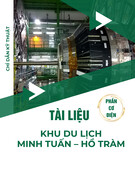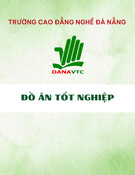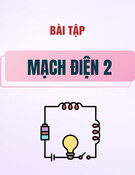
JST: Engineering and Technology for Sustainable Development
Volume 35, Issue 1, March 2025, 059-064
59
Investigating the Glass Properties when Using Electric Arc Furnace Dust
as Coloring Agent
Tran Thi Thu Hien*, Nguyen Sy Long
School of Material Science and Engineering, Hanoi University of Science and Technology, Ha Noi, Vietnam
*Corresponding author email: hien.tranthithu@hust.edu.vn
Abstract
Electric Arc Furnace Dust (EAFD) and wasted glass are two types of waste in industry and daily life, so they
must be recycled to recover some useful elements. The production of colored glass is one of the methods
used to recycle the electric arc furnace dust to take advantage of the coloring element in the dust. To use this
colored glass for decoration, it is also necessary to test its durability. The present study focuses on the
properties of colored glass when using electric furnace dust. The investigation examines the chemical
composition and phase structure of the colored glass, containing varying dust amounts of 0.5:99.5, 2:98, 5:95,
10:90, and 15:85. Using SEM-EDX analysis and compressive strength testing, the results show that changing
the percentage of electric arc furnace dust in the glass makes a difference in its compressive strength. This
change in strength is due to the distribution of dust particles within the glass matrix as a reinforced frame.
Detailed discussion will be presented in the text section.
Keywords: Electric arc furnace dust, waste glass, color glass.
1. Introduction1
The increasing industrial productions generate
annually several tons of dust, slag, sludge, exhaust
gases, and wastewater. Steelmaking using electric arc
furnaces (EAFs) has become a prominent method in
the steel industry, contributing significantly to global
crude steel production. However, this process
generates a notable byproduct known as electric arc
furnace dust (EAFD), comprising approximately
1-2 wt.% of the steel produced [1-3]. EAFD is
recognized for its hazardous components, including
heavy metals like zinc, lead, cadmium, and chromium
[4]. The improper disposal of EAFD poses
environmental and health risks, with potential
contamination of soil and water [5].
EAFD's chemical composition is complex and
varies based on factors such as the type of scrap metal
processed and furnace operating conditions. Typically,
EAFD contains high levels of zinc oxide and
significant amounts of iron oxide, calcium oxide, and
silica [6]. These oxides play a pivotal role in
influencing EAFD's physical and chemical properties,
making it a potential candidate for recycling and reuse
applications.
In recent years, there has been increasing interest
in utilizing EAFD in the production of colored glass,
offering a sustainable solution to address EAFD
disposal challenges while adding value to glass
production processes. Previous studies have explored
incorporating EAFD into glass matrices,
demonstrating its potential as a coloring agent due to
ISSN 2734-9381
https://doi.org/10.51316/jst.180.etsd.2025.35.1.8
Received: Aug 14, 2024; revised: Oct 21, 2024;
accepted: Dec 4, 2024
the presence of several oxides [7-9]. For example, iron
oxide in EAFD imparts various colors to glass,
depending on its concentration and composition [10].
Moreover, recent research has highlighted the
impact of EAFD inclusion on glass mechanical
properties, such as compressive strength and
toughness. The distribution of dust particles within the
glass matrix significantly influences these properties,
with higher EAFD concentrations associated with
reduced compressive strength due to the formation of
weaker phases within the glass structure [11].
Recycling electric furnace dust to recover useful
elements or utilizing iron elements to reuse for iron and
steel production are methods that have been applied
and researched before. In a preceding study, the author
adeptly demonstrated the fabrication of colored glass
from electric arc furnace dust, without zinc reduction,
employing varying masses of 0.5:99.5, 1:99, 2:98, 5:95,
10:90, 15:85, and without dust, amalgamated with
waste glass. Building upon this foundation, the current
investigation delves into the evaluation of compressive
strength in the context of utilizing EAFD for colored
glass production, supplemented by a meticulous
analysis via Scanning Electron Microscopy coupled
with Energy-Dispersive X-ray Spectroscopy
(SEM-EDX), alongside the exploration of novel
chromatic variations.
2. Experimental Procedures
Electric arc furnace dust provided by Thai
Nguyen Iron and Steel JSC and collected waste glass
have the chemical composition shown in Table 1 [12]



































